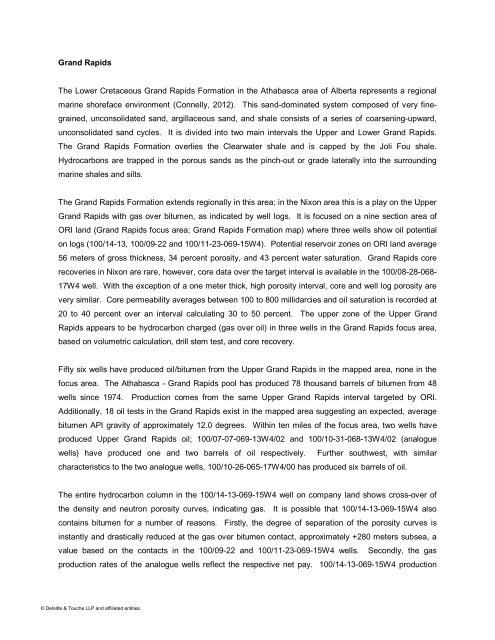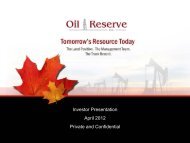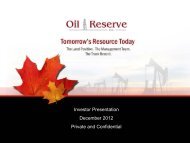Athabasca Viking/Grand Rapids/Nisku Technical ... - Oil Reserve Inc.
Athabasca Viking/Grand Rapids/Nisku Technical ... - Oil Reserve Inc.
Athabasca Viking/Grand Rapids/Nisku Technical ... - Oil Reserve Inc.
Create successful ePaper yourself
Turn your PDF publications into a flip-book with our unique Google optimized e-Paper software.
<strong>Grand</strong> <strong>Rapids</strong><br />
The Lower Cretaceous <strong>Grand</strong> <strong>Rapids</strong> Formation in the <strong>Athabasca</strong> area of Alberta represents a regional<br />
marine shoreface environment (Connelly, 2012). This sand-dominated system composed of very finegrained,<br />
unconsolidated sand, argillaceous sand, and shale consists of a series of coarsening-upward,<br />
unconsolidated sand cycles. It is divided into two main intervals the Upper and Lower <strong>Grand</strong> <strong>Rapids</strong>.<br />
The <strong>Grand</strong> <strong>Rapids</strong> Formation overlies the Clearwater shale and is capped by the Joli Fou shale.<br />
Hydrocarbons are trapped in the porous sands as the pinch-out or grade laterally into the surrounding<br />
marine shales and silts.<br />
The <strong>Grand</strong> <strong>Rapids</strong> Formation extends regionally in this area; in the Nixon area this is a play on the Upper<br />
<strong>Grand</strong> <strong>Rapids</strong> with gas over bitumen, as indicated by well logs. It is focused on a nine section area of<br />
ORI land (<strong>Grand</strong> <strong>Rapids</strong> focus area; <strong>Grand</strong> <strong>Rapids</strong> Formation map) where three wells show oil potential<br />
on logs (100/14-13, 100/09-22 and 100/11-23-069-15W4). Potential reservoir zones on ORI land average<br />
56 meters of gross thickness, 34 percent porosity, and 43 percent water saturation. <strong>Grand</strong> <strong>Rapids</strong> core<br />
recoveries in Nixon are rare, however, core data over the target interval is available in the 100/08-28-068-<br />
17W4 well. With the exception of a one meter thick, high porosity interval, core and well log porosity are<br />
very similar. Core permeability averages between 100 to 800 millidarcies and oil saturation is recorded at<br />
20 to 40 percent over an interval calculating 30 to 50 percent. The upper zone of the Upper <strong>Grand</strong><br />
<strong>Rapids</strong> appears to be hydrocarbon charged (gas over oil) in three wells in the <strong>Grand</strong> <strong>Rapids</strong> focus area,<br />
based on volumetric calculation, drill stem test, and core recovery.<br />
Fifty six wells have produced oil/bitumen from the Upper <strong>Grand</strong> <strong>Rapids</strong> in the mapped area, none in the<br />
focus area. The <strong>Athabasca</strong> - <strong>Grand</strong> <strong>Rapids</strong> pool has produced 78 thousand barrels of bitumen from 48<br />
wells since 1974. Production comes from the same Upper <strong>Grand</strong> <strong>Rapids</strong> interval targeted by ORI.<br />
Additionally, 18 oil tests in the <strong>Grand</strong> <strong>Rapids</strong> exist in the mapped area suggesting an expected, average<br />
bitumen API gravity of approximately 12.0 degrees. Within ten miles of the focus area, two wells have<br />
produced Upper <strong>Grand</strong> <strong>Rapids</strong> oil; 100/07-07-069-13W4/02 and 100/10-31-068-13W4/02 (analogue<br />
wells) have produced one and two barrels of oil respectively. Further southwest, with similar<br />
characteristics to the two analogue wells, 100/10-26-065-17W4/00 has produced six barrels of oil.<br />
The entire hydrocarbon column in the 100/14-13-069-15W4 well on company land shows cross-over of<br />
the density and neutron porosity curves, indicating gas. It is possible that 100/14-13-069-15W4 also<br />
contains bitumen for a number of reasons. Firstly, the degree of separation of the porosity curves is<br />
instantly and drastically reduced at the gas over bitumen contact, approximately +280 meters subsea, a<br />
value based on the contacts in the 100/09-22 and 100/11-23-069-15W4 wells. Secondly, the gas<br />
production rates of the analogue wells reflect the respective net pay. 100/14-13-069-15W4 production<br />
© Deloitte & Touche LLP and affiliated entities.




